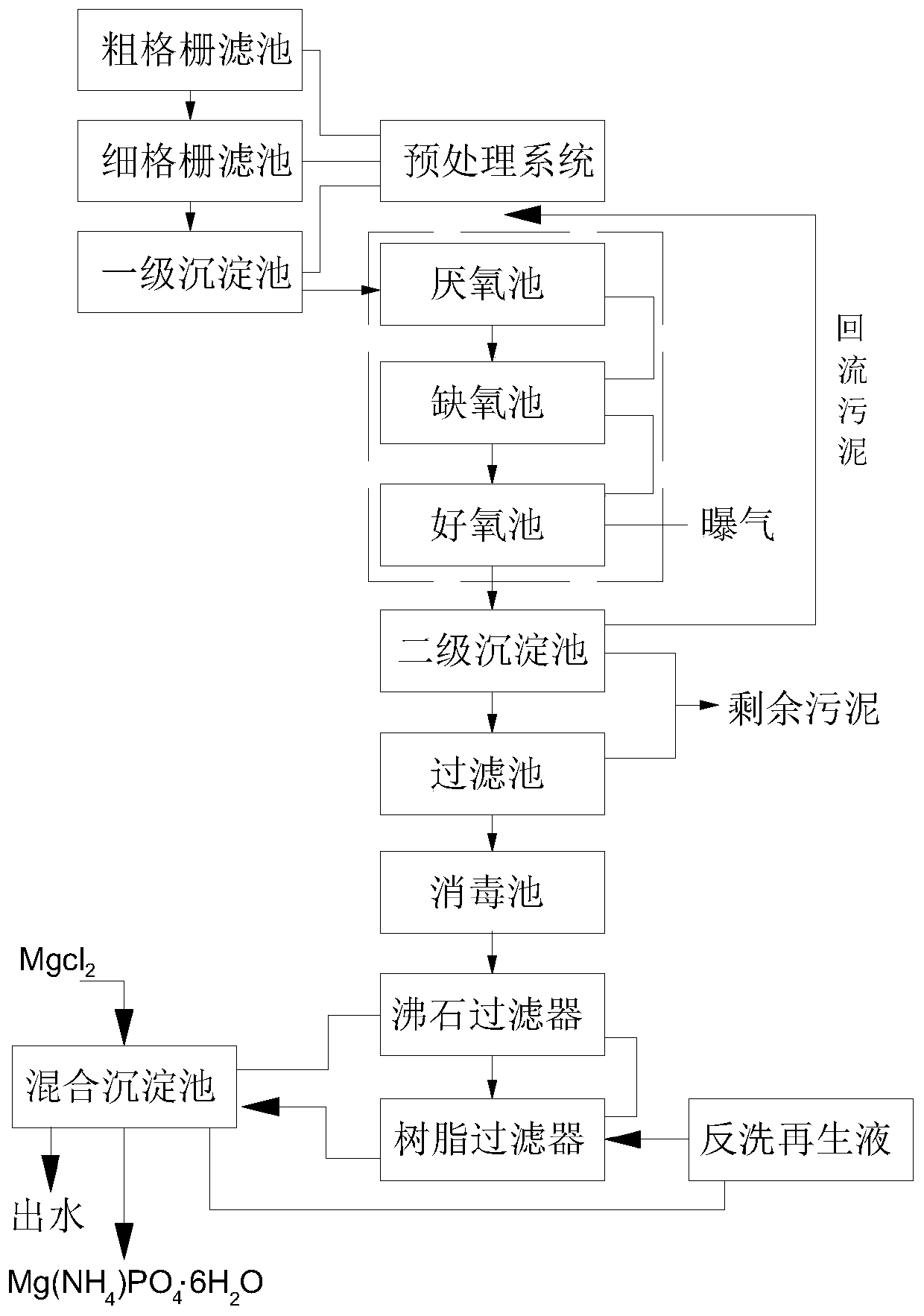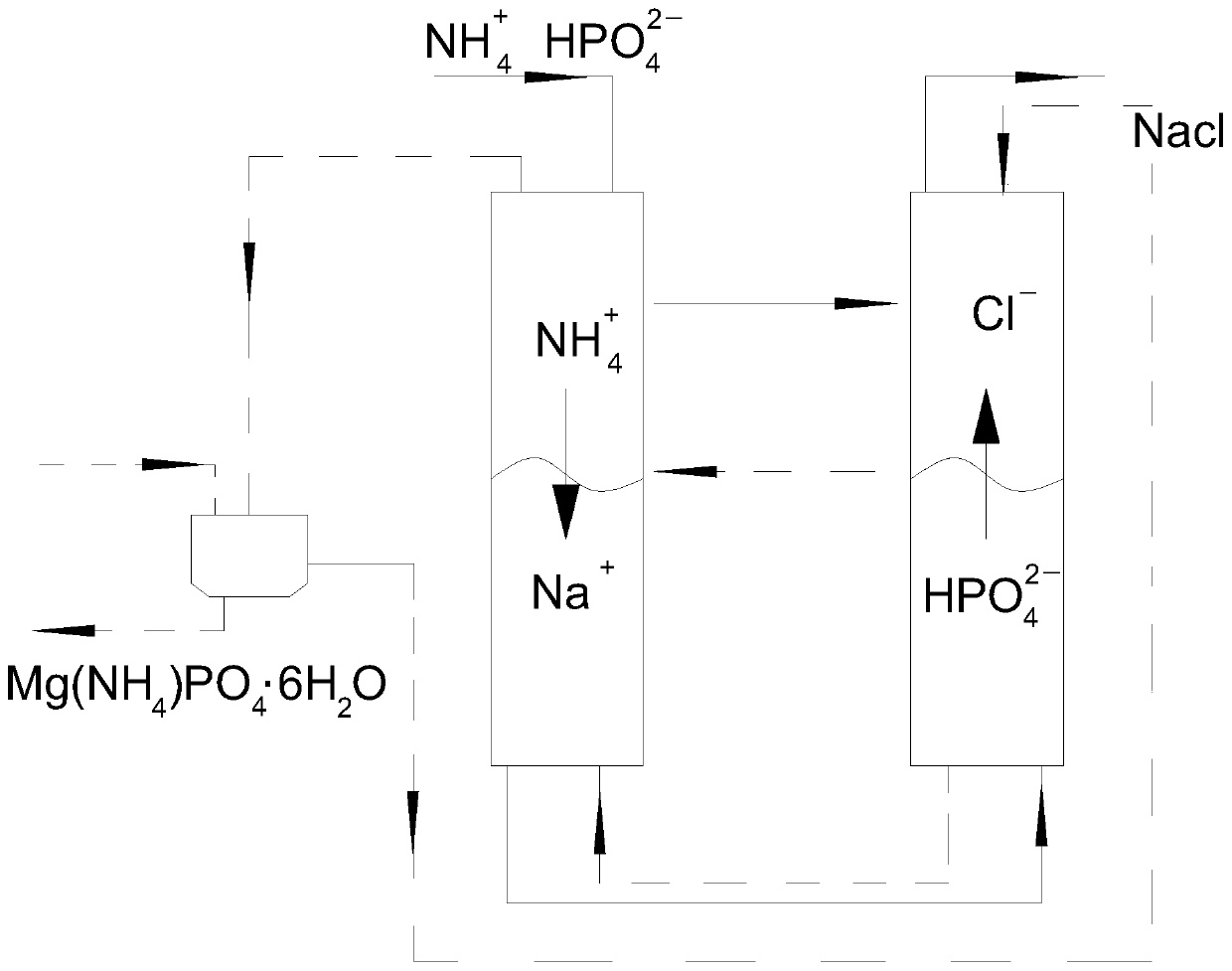Nitrogen and phosphorus advanced treatment system and method for sewage treatment
A technology for advanced treatment and sewage treatment, applied in the field of water treatment, can solve problems such as inability to realize nitrogen and phosphorus recycling, phosphorus does not have selective adsorption, and effluent ammonia nitrogen exceeds the standard, so as to reduce the risk of eutrophication, low cost, and high response speed effect
- Summary
- Abstract
- Description
- Claims
- Application Information
AI Technical Summary
Problems solved by technology
Method used
Image
Examples
example 1
[0044] Rural domestic sewage needs to be discharged up to the standard, and the enriched ammonia nitrogen should be recycled into high-purity nitrogen and phosphorus fertilizers. Taking rural domestic sewage as the influent water source as an example, the influent NH3-N, TP and BOD5 are respectively 8~44.7ppm and 2~ 8.2ppm and 9-20ppm, the traditional treatment method A2O process equipment (the first-level biological nitrogen and phosphorus removal system of the present invention) has an average removal efficiency of ammonia nitrogen of 42.9% and an average removal rate of 67% of total phosphorus. Different seasons The treatment efficiency is: summer>spring>winter. And the traditional treatment method cannot recover nitrogen and phosphorus for reuse. After the same water is treated by the scheme of the present invention, the overall denitrification and phosphorus removal effect of the system is improved, and the removal rate of ammonia nitrogen and total phosphorus can reach mo...
example 2
[0046] Urban domestic sewage is collected by the urban drainage pipe network and transported to the sewage treatment plant for treatment. The effluent needs to meet the level A discharge standard. Taking urban domestic sewage as the influent water source as an example, the influent NH3-N, TP and BOD5 are respectively 6-27.3ppm, 0.8-4.9ppm and 10-25ppm, the traditional treatment method, the average removal efficiency of effluent ammonia nitrogen is 51.2%, the average removal rate of total phosphorus is 65%, and the average removal rate of BOD5 is 85%. Most of the organic matter in the wastewater is used as the organic nutrients of the different microorganisms, and finally converted into microorganisms and CO2, H2O. According to the Level 1 A standard in the "Emission Standard of Pollutants for Urban Wastewater Treatment Plants" (GB18918-2002), its emission indicators are shown in the following table.
[0047]
[0048] The same water passes through the nitrogen and phosphorus advan...
example 3
[0050] In order to avoid eutrophication, surface eutrophic water bodies need to meet the environmental quality standards of surface water. Taking river water as an influent source for example, the influent NH3-N, TP and BOD5 are respectively 2.6~17.3ppm, 0.3~2.0ppm and 10~ 28ppm, according to the traditional treatment method, the average removal efficiency of effluent ammonia nitrogen is 52.2%, and the average removal rate of total phosphorus is 69%. According to the surface water environmental quality standard (GB3838-2002), its indicators are shown in the following table, unit: mg / L.
[0051] Type I Type II Class III Type IV Class Ⅴ NH3-N0.150.511.52 TP 0.020.10.20.30.4
[0052] The same water is treated by the technical scheme of the present invention. After passing through the zeolite filter and the resin filter, the overall denitrification and phosphorus removal effect of the system is improved, and the removal rate of ammonia nitrogen and total phosphorus can reach mor...
PUM
 Login to View More
Login to View More Abstract
Description
Claims
Application Information
 Login to View More
Login to View More - R&D
- Intellectual Property
- Life Sciences
- Materials
- Tech Scout
- Unparalleled Data Quality
- Higher Quality Content
- 60% Fewer Hallucinations
Browse by: Latest US Patents, China's latest patents, Technical Efficacy Thesaurus, Application Domain, Technology Topic, Popular Technical Reports.
© 2025 PatSnap. All rights reserved.Legal|Privacy policy|Modern Slavery Act Transparency Statement|Sitemap|About US| Contact US: help@patsnap.com



